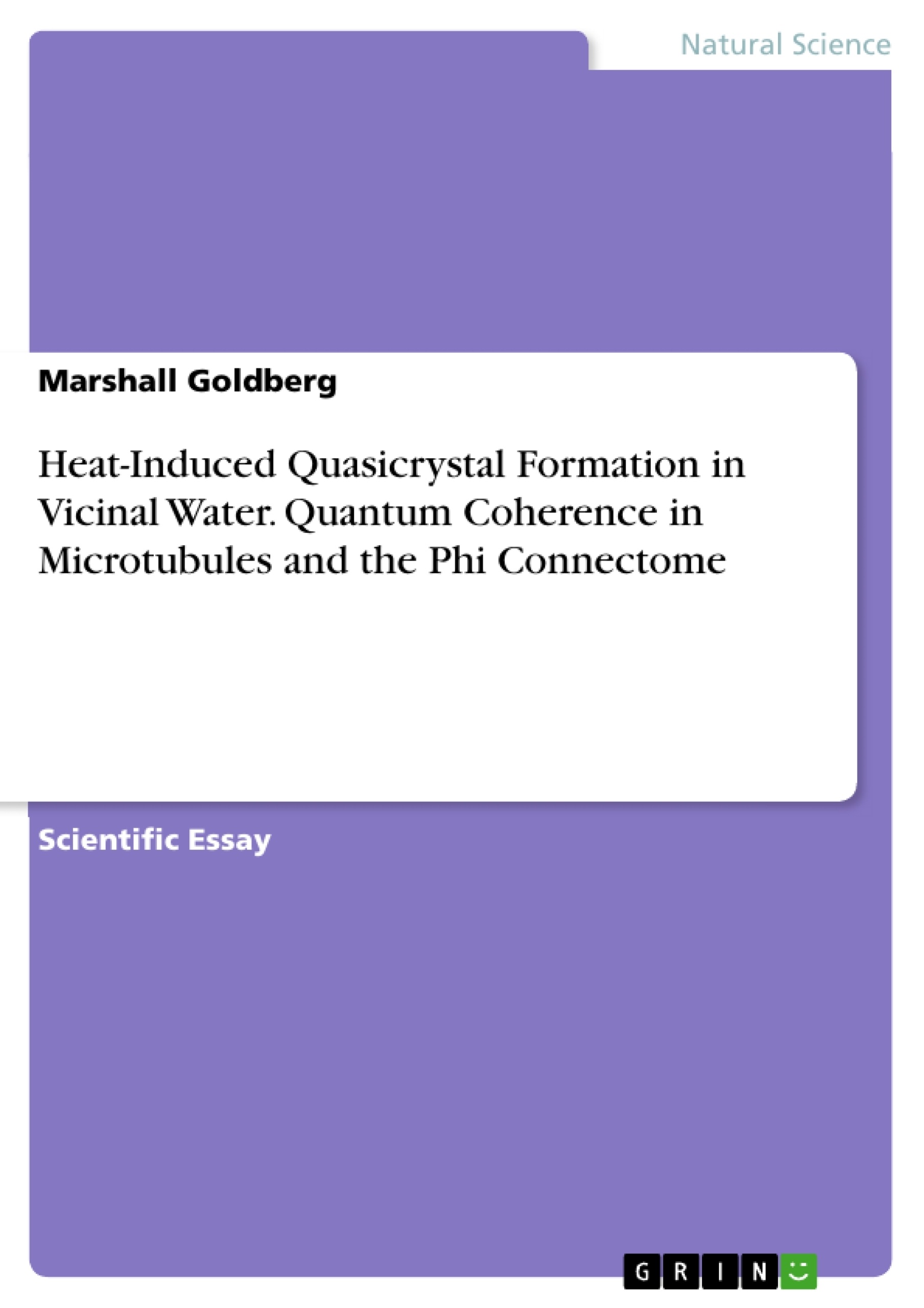This paper proposes a mechanism producing quantum coherence in microtubules and questions, how this quantum coherence is scaled up to include the cerebral cortex. Microtubules are part of the cytoskeleton in all cells. In neurons, they are thought to play a key role in consciousness. The Orch-OR theory of consciousness maintains that consciousness—qualia, the feeling of life itself—requires quantum processes, and that Turing machine algorithms, though capable of astonishing calculations, lack insight and understanding. "Insight" as Gödel’s incompleteness argument suggests may not be demonstrable by an algorithmic process. Consciousness (Chalmer’s explanatory gap) may depend on more than calculation. In the current consciousness paradigm, quantum coherent microtubules are considered the primary unit of "computation" rather than neurons and the synapses between neurons.
Inhaltsverzeichnis (Table of Contents)
- Vicinal Water and Quantum Coherence in Microtubules
- Scaling up the Quantum Property of the Microtubule to the Cerebral Cortex/Brain
- Symmetry Breaking and Self-Synthesis
- Phyllotaxis, the Phi Connectome and Bandyopadhyay's Sphere-Spiral Fractal Structure
- The Phi Connectome-Formation
- Information Transmission Delays in the Brain and Consciousness
- Paradoxical Results in Measurements of the 'Time' of Conscious States
- The Cellular Automaton and Quantum Coherent States
- Formation of Microtubules in Prokaryotes and Self-Synthesis of the Phi Connectome
- Microtubule polarity in axons, soma, dendrites, and the phi connectome
- Phi Connectome Connectivity—Quantum or Electromagnetic Field?
- Discussion
Zielsetzung und Themenschwerpunkte (Objectives and Key Themes)
This paper explores the possibility of quantum coherence within microtubules and its implications for consciousness. It proposes a mechanism for generating this coherence and investigates how it might be scaled up to encompass the cerebral cortex.
- Quantum coherence in microtubules
- Role of vicinal water in generating quantum coherence
- Scaling up quantum coherence to the brain
- The Phi Connectome and its implications for consciousness
- Quantum processes and consciousness
Zusammenfassung der Kapitel (Chapter Summaries)
- Vicinal Water and Quantum Coherence in Microtubules: This chapter introduces the concept of vicinal water and its potential role in generating quantum coherence within microtubules. It explains how the interaction of water tetrahedra with tubulin molecules could lead to quantum properties.
- Scaling up the Quantum Property of the Microtubule to the Cerebral Cortex/Brain: This chapter explores the possibility of scaling up quantum coherence from microtubules to the entire cerebral cortex. It discusses how the Phi Connectome, a network of microtubules connected by the golden ratio, could facilitate this process.
- Symmetry Breaking and Self-Synthesis: This chapter examines the concept of symmetry breaking and its role in the self-synthesis of the Phi Connectome. It highlights the potential role of quantum properties in this process.
- Phyllotaxis, the Phi Connectome and Bandyopadhyay's Sphere-Spiral Fractal Structure: This chapter investigates the relationship between phyllotaxis, the Phi Connectome, and Bandyopadhyay's sphere-spiral fractal structure. It discusses how these structures might be interconnected and relevant to consciousness.
- The Phi Connectome-Formation: This chapter explores the formation of the Phi Connectome and its potential implications for information processing and consciousness. It examines how the golden ratio might play a role in the organization of microtubules within the brain.
- Information Transmission Delays in the Brain and Consciousness: This chapter investigates the role of information transmission delays in the brain and how they might relate to consciousness. It explores the possibility of quantum processes influencing the timing of conscious experience.
- Paradoxical Results in Measurements of the 'Time' of Conscious States: This chapter examines paradoxical results in measurements of the "time" of conscious states. It discusses potential explanations for these anomalies and their implications for understanding consciousness.
- The Cellular Automaton and Quantum Coherent States: This chapter explores the relationship between cellular automata and quantum coherent states. It discusses how these concepts might be relevant to understanding the emergence of consciousness.
- Formation of Microtubules in Prokaryotes and Self-Synthesis of the Phi Connectome: This chapter investigates the formation of microtubules in prokaryotes and their potential role in the self-synthesis of the Phi Connectome. It examines the evolutionary origins of this structure.
- Microtubule polarity in axons, soma, dendrites, and the phi connectome: This chapter discusses the polarity of microtubules in axons, soma, and dendrites and their potential role in the Phi Connectome. It explores how this polarity might influence information flow within the brain.
- Phi Connectome Connectivity—Quantum or Electromagnetic Field?: This chapter explores the nature of connectivity within the Phi Connectome. It considers the possibility of quantum or electromagnetic field interactions as potential mechanisms for information transfer.
Schlüsselwörter (Keywords)
This work focuses on the role of quantum coherence in microtubules, the Phi Connectome, and the implications for consciousness. It explores the relationship between vicinal water, quantum coherence, symmetry breaking, and the golden ratio. Other key concepts include information transmission delays, cellular automata, and the evolutionary origins of microtubules.
- Quote paper
- Dr. Marshall Goldberg (Author), 2020, Heat-Induced Quasicrystal Formation in Vicinal Water. Quantum Coherence in Microtubules and the Phi Connectome, Munich, GRIN Verlag, https://www.grin.com/document/961537



